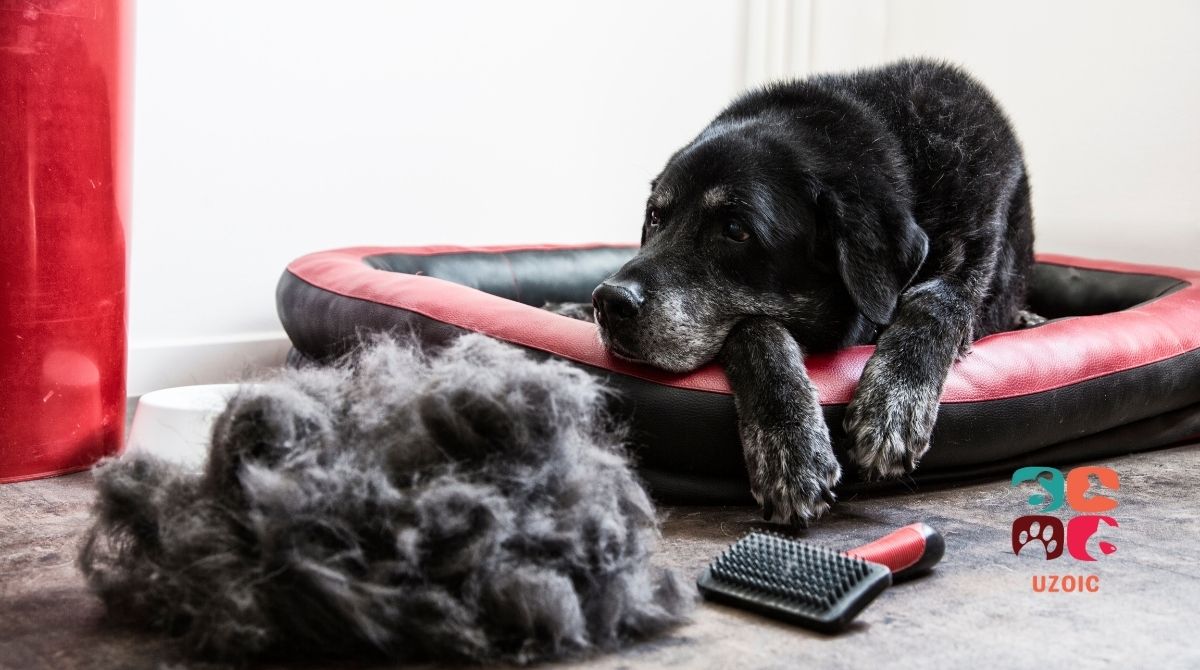If you’re like most pet owners, you probably wonder how long it takes for dog hair to grow back after you’ve had it shaved. It’s a common question, and the answer may surprise you! In this blog post, we will discuss the hair growth cycle in dogs and how long it takes for dog hair to grow back after being shaved. We will also provide tips on how to help your dog’s hair grow back faster.
A dog’s coat is made up of two different types of hair: the undercoat and the topcoat. The undercoat is a dense, soft layer of fur that helps to insulate the dog’s body and protect it from the elements. The topcoat is a thinner layer of hair that provides additional protection and gives the dog’s coat its characteristic shine. Many factors, including genetics, health, and diet, can affect the growth rate of a dog’s hair. For example, dogs fed a diet rich in protein and essential fatty acids are likely to have healthier coats than those that are not.
The hair growth cycle in dogs is similar to that of humans. The hair follicle grows a new hair shaft, which pushes the old hair shaft out. This process is called shedding. Shedding occurs more frequently in certain times of the year (such as during summer) and can also be affected by factors such as stress, illness, or pregnancy. After the old hair shaft is shed, a new one begins to grow in its place.
The rate of hair growth varies from dog to dog and depends on the type of hair. For example, dogs with thick, double coats will typically have a slower rate of hair growth than those with single coats.
Table of Contents
How Long Does It Take For Dog Hair To Grow Back?
A research study titled “An analysis of canine hair re-growth after clipping for a surgical procedure” (funded by the Small Companion Animal Grant, College of Veterinary Medicine, University of Minnesota) found that dog hairs grew to pre-clipped length in 14.6 weeks, 14.5 weeks, 13.6 weeks and 15.4 weeks when shaved in the spring, summer, autumn and winter, respectively.
Other studies have found that dog hair grows back at an average rate of 0.065 mm/day.
How can I get my dogs hair to grow back faster?
Of course, there are ways to help your dog’s hair grow back faster. One way is to brush your dog regularly. Brushing stimulates the hair follicles and helps distribute the natural oils from the skin, which can promote hair growth. You can also try giving your dog supplements that are rich in omega-fatty acids, such as fish oil.
Omega-fatty acids help to nourish the hair follicles and promote healthy hair growth. Adding an omega oil supplement to your dog’s diet is an easy way to ensure that they are getting the nutrients they need for a healthy coat.
Additionally, regular grooming can also help to promote faster hair growth. By gently brushing the dog’s coat daily, you can help to stimulate the hair follicles and promote healthy growth. Try using a suitable grooming brush for your dog to help hair growth. I recommend that you combine grooming with bathing your dog with a decent antibacterial and antifungal shampoo that can help in promoting hair growth.
By following these simple tips, you can help your dog’s hair grow back faster after being shaved. Additionally, you can help to keep your dog’s coat healthy and free from tangles by brushing regularly and feeding a nutritious diet.
Does shaved dog hair grow back?
Yes, shaved dog hair does grow back. The hair follicles are not damaged when shaved, so the hair will grow back. However, it may take a few weeks for the hair to reach its full length. The new hair may also be a different color or texture than the original hair. For example, if your dog has black hair, the new hair may be lighter in color. Shaved dog hair will also require more grooming than before, as it will be more likely to tangle and mat. However, shaved dog hair will eventually regrow to its original state.
Does coconut oil help dogs hair grow back?
Coconut oil can help improve the health of your dog’s skin and coat, which can promote hair growth. Coconut oil is rich in fatty acids, which help to nourish the skin and reduce inflammation. In addition, the antifungal and antibacterial properties of coconut oil can help prevent skin infections that can lead to hair loss. To use coconut oil for your dog’s coat, simply massage a small amount into their fur before shampooing. You can also add a teaspoon or two to their food each day. With regular use, you should notice an improvement in your dog’s coat within a few weeks.
Will my dog’s hair grow back after hot spots?
Yes, your dog’s hair will grow back after hot spots. Hot spots are a common skin condition in dogs that can cause the hair to fall out. However, the hair will typically grow back within a few weeks. Hot spots can be caused by allergies, infections, or other skin problems. If your dog is prone to hot spots, it’s important to keep an eye on the area and seek veterinary care. With proper treatment, your dog will fully recover, and their fur will grow back as good as new.
Hot spots, also known as pyotraumatic dermatitis, are a common skin condition in dogs that can cause discomfort. An allergic reaction or an infection typically causes them, and they appear as red, inflamed patches of skin. While hot spots can be very painful, they usually heal quickly with proper treatment. In most cases, the hair will grow back within a few weeks. However, if the hot spot is particularly severe, the hair may take longer to grow back or may not grow back at all. If you’re concerned about your dog’s hot spots, your best course is to consult with your veterinarian.
Why is my dog’s fur not growing back?
One common reason for a dog’s hair not growing back is a lack of nutrition. Ensure that your dog is getting enough of the right nutrients by feeding them a high-quality diet. Another reason for slow-growing hair could be allergies or poor skin health. Consult with your veterinarian to rule out any underlying health issues. Finally, certain medications can cause hair loss as a side effect. If your dog is taking any medication, talk to your vet about whether hair loss is a possible side effect. In most cases, dog’s hair will eventually grow back with time and proper care. However, if the hair loss persists, it is best to consult with a veterinarian.
How fast does puppy hair grow?
The average growth rate for puppy hair is about 6 inches per year. Several factors contribute to the faster growth rate of puppy hair:
- Puppies have more active follicles than adults.
- The hair shafts of puppies are thinner and contain less pigment. This allows them to grow at a faster rate.
- Puppies have higher levels of a hormone called IGF-1, which promotes cell growth and speeds up the hair growth cycle.
All of these factors combine to give puppies their characteristic fluffy coats.
A puppy’s coat will usually grow the fastest during the first six months of life. After that, the growth rate will start to slow down. The type of breed can also affect how fast a puppy’s hair grows. For example, toy breeds typically have slower-growing coats than larger breeds. Additionally, certain health conditions can increase the growth rate of a puppy’s hair. If you are concerned about your puppy’s hair growth speed, it is best to consult with a veterinarian. They will be able to assess your puppy’s health and advise you on the best course of action.
Also read:
- Why Your Puppy Is Licking Its Crate Bars!
- Does Taste of the Wild give dogs diarrhea?
- Why Does My Dog Keep Pooping On The Sofa?
- Why Does My Dog Freeze When I Put Clothes On Him
- Why Does My Dog Lick My Pillow: The Surprising Science Behind Canine Behavior
Final Thoughts
So, how long does it take for dog hair to grow back? It will take around four to six weeks for the hair to start growing back in. However, depending on the severity of the haircut and how quickly your dog’s hair grows, it could take up to eight or twelve weeks for new hair growth to be visible. During this time, make sure you regularly brush your dog’s coat so that any loose hairs can be removed and minimize matting. If you have any questions or concerns about your pet’s health, please consult with a veterinarian. Thanks for reading!


